Capturing the full power of grass – understanding the full nutritional value of grass is key to maximum utilisation. As grazing or silage, grass is the foundation for most forage-based systems. It is the cheapest source of ruminant feed and the most important factor in modern dairy, beef and sheep farming profitability.
Livestock farmers, however, need to take full advantage of grass by maintaining sward quality and productivity. They need to manage intakes through effective grazing and winter-feeding plans.
It is also important to have a good understanding of the nutritional qualities of grass. If you don’t know the full feed value of grass, there is a chance it will either be under-utilised or inaccurately supplemented – its potential will then be lost.
In this guide, we provide simple definitions and highlight the importance of different components and offer pointers on how to attain the best results. Grass is also commonly grown with white and red clover, so we provide references where applicable to the contribution of these legumes, which can fix nitrogen.
Contents
- Why is dry matter important in grass?
- Why are the D-value and ME of grass important?
- Why is water-soluble carbohydrate important in grass?
- Why is protein important in grass?
- Why is fibre important in grass?
- Why are lipids important in grass?
- Why are minerals and vitamins important in grass?
Why is dry matter important in grass?
The dry matter (DM) content of forage (measured as a percentage) is the proportion of total components (fibres, proteins, ash, water-soluble carbohydrates, lipids, etc) remaining after water has been removed.
Knowing the dry matter percentage of forage is important. The lower the dry matter content, the higher the fresh weight of forage required to achieve a target nutrient intake, whether this is grazed grass or conserved forage.
Dry matter is also used as a term to measure yield. Recorded as kg DM/ha, this is used as a measure of sward carrying capacity (stocking rate) and is an essential element of effective grazing management. It is also used to measure silage crop yields.
In terms of dry matter content, field and weather conditions will cause significant variation, and there are also inherent differences between diploid and tetraploid varieties. All other factors being equal, diploids have higher dry matter content (typically 18-26% DM) than tetraploids (15-20% DM), due to diploids having smaller cells and a lower cell wall to cell contents ratio.
This means ruminants fed entirely on a tetraploid sward will need to consume as much as one-third more fresh grass per day to achieve the same nutritional intake as from a purely diploid sward.
Looking at dry matter yield, modern ryegrasses have been bred for maximum production. The best-rated perennial ryegrass varieties on the Recommended List are now capable of grazing or conservation yields in excess of 11 t DM/ha whilst weed grasses (e.g. creeping bent or annual meadow grass) can yield as little as 2 t DM/ha.
Production from ryegrasses over a season follows the classic growth curve, peaking at around 120 kg DM/ha/day in May/June and typically dipping to around one-third of peak levels by early autumn.
In grazing terms, the aim should be to present grazing that offers the ideal balance of fresh nutritious growth with the appropriate fibre content for optimal rumen passage. This balance is best achieved by using a grazing rotation of 18-25 days in peak season.
Poor sward management will increase the proportion of dead and dying plant material, resulting in a significant decline in forage quality and intake potential. By reseeding grassland regularly, you can maintain higher quality and production levels.
When making silage, the aim should be to cut at 16-20% dry matter and ensile at 30-35% dry matter (for clamp silage) and 35-40% (baled). This will ensure good fermentation and optimum intakes, and minimum risk of aerobic instability.
Fresh grass requirements at different dry matters
| Total ME supplied (MJ/cow/day) | Grass ME (MJ/kg DM) | Grass DM (%) | Fress grass required (kg/cow/day) |
| 160 | 10 | 16 | 100 |
| 160 | 10 | 18 | 89 |
| 160 | 10 | 20 | 80 |
| 160 | 10 | 22 | 73 |
| 192 | 12 | 16 | 100 |
| 192 | 12 | 18 | 89 |
| 192 | 12 | 20 | 80 |
| 192 | 12 | 22 | 73 |
Pointers on dry matter
- Factor in grazing and/or cutting DM yield when selecting the best varieties from the Recommended List
- Diploids generally aid grazing efficiency whilst tetraploids are typically more suited to cutting
- Consider pre-cutting grazing swards as a means of increasing dry matter intakes
- Remember that livestock on wet pasture will require more fresh weight of forage per day
- Delaying cutting for silage increases yield but decreases quality
The clover effect
- Overall dry matter yield from a mixed grazing sward with optimum white clover content is broadly compatible with a straight ryegrass sward, assuming average UK nitrogen
- fertiliser applications
- When red clover is included in silage leys, only use light conditioning on the mower (e.g. rubber roller or flails fully open)
- Red clover content will be higher in later cuts, so a longer wilt is required to achieve comparable dry matter content in the silage
Why are the D-value and ME of grass important?
D-value is the measure of digestibility or the proportion of the forage that can be digested by a ruminant. This digestible part of the forage is made up of crude protein, carbohydrates (including digestible fibres and sugars) and lipids (oils).
ME is the amount of energy that an animal can derive from the feed. It is measured in megajoules of energy per kilogram of forage dry matter (MJ/ kg DM). ME is directly correlated with D-value because any feed has to be digestible in order for the energy to be available.
One percentage point of D-value equates to 0.16 MJ/kg DM of ME. A proportion of ME is available as an energy source for rumen microbes. This is referred to as fermentable ME (FME) and is largely comprised of plant cell walls.
D-value (and ME) is highest in the top-ranking ryegrasses on the Recommended List, with figures for Grazing D-value and First Cut D-value available on all listed varieties.
Leading varieties will be in the 75-80 D-value range, up to five percentage points higher than average varieties on the list and higher still than non-listed varieties. Weed grasses will be substantially lower in D-value than modern ryegrasses.
In all cases, D-value is highest in grass when the sward has fresh leafy growth and declines as the plants become more mature (stemmy). The decline in D-value is highest after ear emergence (heading). Grass cut for silage will typically lose 2 percentage points in D-value between cutting and feeding.
The higher the D-value and ME in forage, the better ruminant performance will be. In the UK, NIAB estimates that a single point increase in D-value (or 0.16 MJ/kg ME) equates to 0.26 litres of milk per dairy cow per day, 40g/day extra beef liveweight gain and 20g/day of extra lamb liveweight gain.
Similar work at Teagasc in Ireland and DARDNI put the increase in milk yield higher at 0.33 and 0.4 litres per cow per day respectively
Variation in D-value and ME between grass species
| Grass species | Average D-value (%) | Average ME (MJ/kg DM) |
| Perennial ryegrass | 73 | 11.7 |
| Timothy | 68 | 10.9 |
| Smooth meadow grass | 61 | 9.8 |
| Red fescue | 61 | 9.8 |
| Creeping bentgrass | 58 | 9.3 |
Pointers on D-value and ME
- Select the highest-ranking varieties on the Recommended List
- Use a rotational (18-25 day) paddock grazing system with entry determined by the ‘Three Leaf System’
- Consider soil nutrient availability and when applying fertilizer always apply in line with Fertiliser Manual RB209
- Cut for silage prior to stem thickening, or approximately one week before heading
- Manage to minimise diseases that will reduce D-value (e.g. crown rust, leaf spot)
- When necessary, stop grazing swards to prevent heading
The clover effect
- White and red clovers typically have D-values comparable to the highest-ranking ryegrass varieties, with a greater proportion of the digestible material being in the form of crude protein (e.g. less carbohydrate)
- The optimum white clover content in a grazing sward is an average of 30% over a grazing season
- When including red clover in a silage ley, it is important to use compatible ryegrass varieties to achieve the best overall
D-value at cutting. As with ryegrass, D-value of red clover declines rapidly with increased crop maturity, with the target being to cut when no more than half the plants are in bud
Why is water-soluble carbohydrate important in grass?
Water-soluble carbohydrates (WSC) are the soluble sugars that are quickly released from grass within the rumen. These sugars provide a readily available source of energy for the rumen microbes that are responsible for digesting forage.
These sugars also provide the fuel for silage fermentation. The higher the sugar, the better the silage is preserved and the higher the feed value for the animal.
Higher WSC is a major differentiating factor in modern ryegrasses bred at IBERS Aberystwyth University over 30 years. Varieties higher in WSC than conventional varieties are now available as Aber High Sugar Grass. The Aber HSG range now includes intermediate and late heading diploid and tetraploid perennial ryegrasses and hybrid ryegrasses.
Relative differences in WSC are maintained between ryegrass varieties even though the content typically rises and falls over a season, with varying weather conditions and even over the period of a day. On a warm sunny summer day, WSC content can be as high as 35% of dry matter, whilst on a cool cloudy autumn day it can be as low as 10%, but at either end of the spectrum differences between varieties are maintained.
A high WSC will generally mean forage composition is closer to the 2:1 WSC-to-crude protein ratio that animal models suggest is the target for optimum nitrogen use efficiency in the rumen. This means that more of the feed is converted into milk and meat, with less going to waste in urine (and methane).
Under ideal growing conditions, modern Aber HSG ryegrasses will achieve the optimum ratio of 2:1 for WSC-to-protein. Wetter silage ultimately uses up more sugar to achieve a stable fermentation, leaving less for the animal.
Average WSC over five years
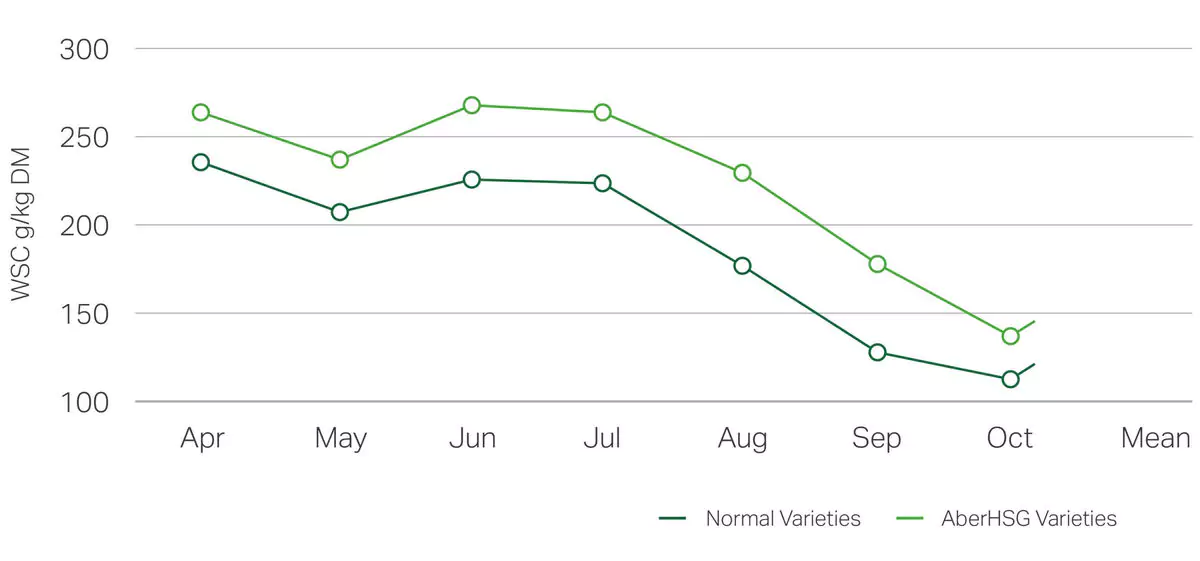
Effect of DM at ensiling on WSC content of silage as a result of fermentation
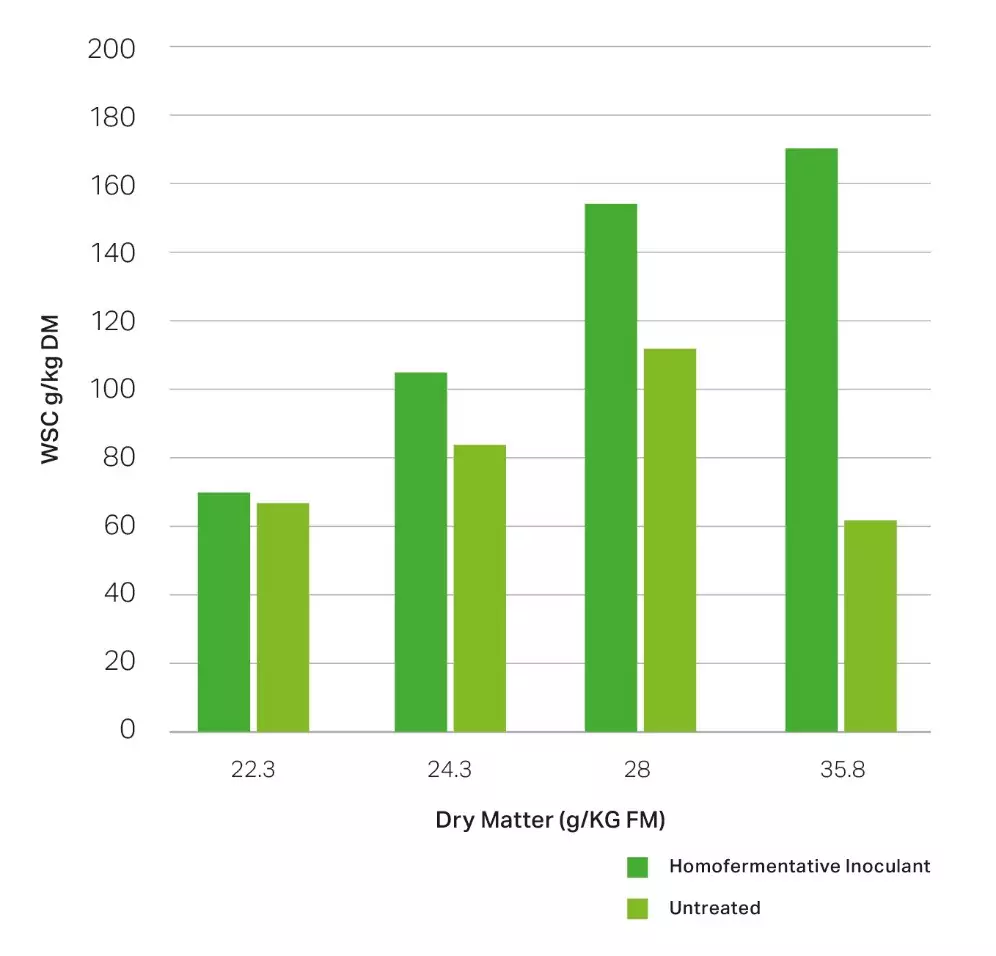
Wetter silage ultimately uses up more sugar to achieve a stable fermentation, leaving less for the animal.
Pointers on WSC
- Select and sow grass and silage mixtures that are 100% Aber HSG to maximise WSC
- Avoid over-use of fertiliser by following RB209 guidelines
- Cut for silage late in the afternoon to maximise the WSC content
- Avoid making overly wet silage (below 28% DM) as this may result in sugar losses in the effluent and increases the effluent; wet silage also has increased need for sugars to create a good fermentation and stable silage
- WSC generally peaks 3-5 weeks after grazing or cutting
- Manage swards to avoid diseases that will reduce WSC (e.g. crown rust, leaf spot)
The clover effect
- White clover is generally lower in WSC and higher in protein, so it important to maintain the target of 30% white clover sward content over a grazing season for optimum performance
- Red clover is generally lower in WSC than ryegrass, so growing it in combination with Aber HSG varieties is beneficial for the silage fermentation process
- Aim for a minimum dry matter of 30% when ensiling red clover and ryegrass to increase the concentration of WSC in the forage
Why is the protein content of grass important?
Protein is a large and expensive component of livestock rations, and reliance on imported sources (e.g. soya) leaves businesses vulnerable to price volatility and supply. Greater use of homegrown protein is, therefore, desirable.
How much protein is in grass?
Protein in grass is generally reported as total crude protein (CP), which is 6.25 times the nitrogen content. Typically, around 80% of the crude protein in fresh grass is true protein. The remaining fraction is often referred to as non-protein nitrogen.
Both types of nitrogen can be used by the animal but the true protein is used more efficiently for meat and milk production. A larger part of the non-protein nitrogen is used inefficiently and is excreted by the animal.
Crude protein can be split into effective rumen degradable protein (ERDP) and digestible undegradable protein (DUP). ERDP, which is by far the biggest part of fresh forage protein, can be broken down by rumen microbes and converted into microbial protein that is digested later. DUP passes through the rumen intact and can be broken down and digested in the small intestine.
Crude protein content can vary within single varieties and between varieties and is influenced by management factors such as nitrogen fertiliser applications and crop maturity.
The proportion of the crude protein that is available as true protein is lowest in the period after nitrogen fertiliser is applied, but rises as the grass grows and converts non-protein nitrogen into true protein.
In silage, the proportion of crude protein that is available as true protein is affected by the fermentation. A better fermentation results in more of the crude protein remaining as true protein.
Protein in grass and silage
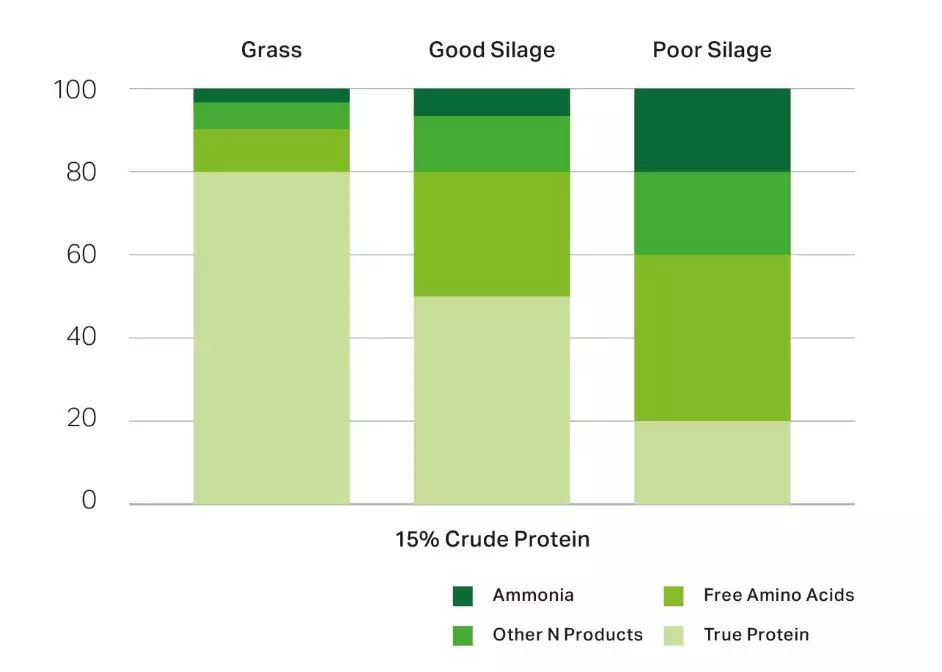
Does grass have protein?
Yes, and grazed grass provides the best source of true protein, as shown in the chart above. With good ensiling practice, you can preserve more of the true protein in grass silage.
How much protein does grass have?
When comparing the typical nutrient content of farm feeds, we can see that grazed leafy ryegrass contains 16-25% protein within dry matter. This is higher than the majority of farm feed types listed in the table below.
| Grass ME (MJ/kg DM) | Grass DM (%) | Protein (% in DM) | |
| Grazed leafy ryegrass | 15-20 | 11.5 | 16-25 |
| White clover | 10-18 | 12.0 | 25-30 |
| 3-cut grass silage | 16-28 | 10.5-11.5 | 12-18 |
| Big bale silage | 35 | 10.5-11.5 | 12.5-17.5 |
| 18% protein compound | 86 | 10.3-12.0 | 20.9 |
| Soya bean meal | 88 | 12.9 | 47.0 |
| Barley | 86 | 13.2 | 12.3 |
Animal research has shown that typically only about 20% of protein consumed by ruminants is used (to maintain the animal and produce meat or milk); the rest is lost in waste products.
A better balance of protein and energy supply to the rumen will improve the proportion of protein that is used. Feeding forage (as grazed grass or silage) with a higher sugar (WSC) content has been shown to improve protein utilisation in ruminants.
Given the optimum balance of protein and energy sources, dietary crude protein concentrations can routinely be as low as 12-14% of dry matter without any detriment to livestock productivity (14% for milk production).
Pointers on protein
- Aber HSG varieties are bred for improved protein-to-energy balance
- Apply fertiliser in line with the Fertiliser Manual RB209, and 2-3 days after grazing or cutting
- Avoid making overly wet silage (below 28% DM) as this may result in soluble protein losses in the effluent
- Optimum protein concentrations occur 3-5 days after cutting or grazing
The clover effect
- White clover is generally higher in protein than ryegrass; it is important to maintain an optimum balance in grazing swards of an average 30% of dry matter over the season
- Red clover is a high protein forage (typically 22% crude protein). It contains an enzyme (PPO) that in silage helps to maintain the proportion of true protein
Why is fibre important in grass?
Fibre is essential in the ruminant ration to provide the ‘scratch factor’ essential to stimulate rumen function. There is an important balance to be achieved in all rations for optimum performance.
Fibre is measured as NDF (neutral detergent fibre), this being the insoluble fibre fraction (cellulose, hemicellulose, pectin and lignin) that remains after boiling in a neutral detergent solution.
Carbohydrates within NDF are not as readily accessible as those in the WSC component of ryegrasses. However, NDF content is important for predicting ruminant voluntary intake.
The proportion of NDF that can be digested by ruminants is referred to as dNDF. This is a secondary source of slowly released carbohydrates that provides a useful source of fermentable energy for ruminants within the rumen and hind gut.
Does grass have fibre?
Yes, and grass fibre concentration can vary greatly during the growing season. It is at its highest (and the grass least digestible) when the sward is producing reproductive seed heads rather than vegetative leaves. Conversely, during the early spring when fresh growth is at its peak, fibre content is typically at its lowest (grass is most digestible).
The principle target with fibre is to maximise animal voluntary intake while ensuring sufficient rumen digestion time. For grazing, the optimum NDF content of grass should be in the range of 30-40% of total dry matter, with dNDF around 20-30% of total dry matter, or roughly 60-75% of the total fibre content in a digestible form.
When grass fibre content falls below these optimum levels (e.g. early spring flush) supplementary feeding of fibre may be necessary to prevent grass from passing through the rumen too rapidly.
When making silage, it is important to cut before grass becomes too mature (pre-heading) to avoid a significant reduction in digestibility.
Grass fibre and dry matter intake
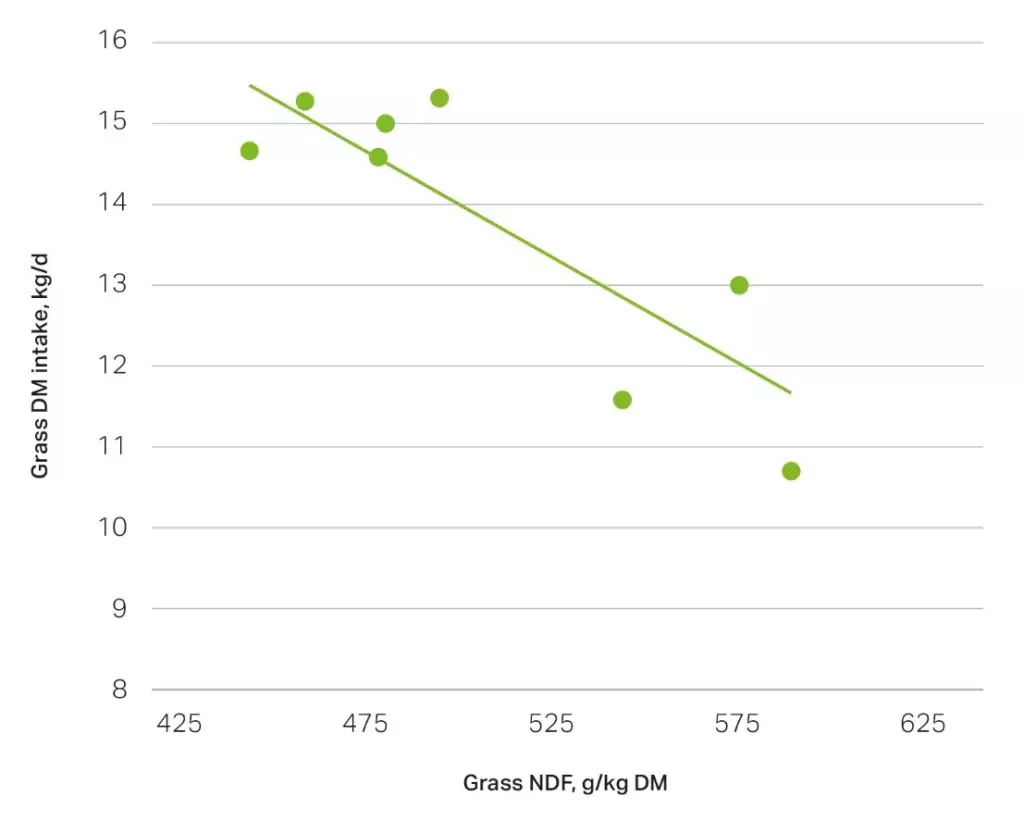
Pointers on NDF and dNDF
- Rotational grazing (18-25 days) using the Three Leaf System to determine when to graze will optimise both NDF and dNDF levels in grass
- Topping will remove stemmy growth and stimulate fresh growth (and avoid NDF being too high) but good grazing management should ideally avoid the need for topping
- Take silage cuts before grass goes to head to avoid NDF rising too high
- Manage grazing and cutting swards to avoid diseases (e.g. crown rust, leaf spot) that will increase NDF at the expense of overall quality
The clover effect
- The clover concentration of white and red clover is lower than that of ryegrass and can have the potential to increase voluntary intake
- The physical form of fibre in clovers typically breaks down in the rumen more quickly than the fibre in ryegrass
Why are lipids important in grass?
Lipids in forage grasses contain a high proportion of polyunsaturated fatty acids (PUFA). These are the ‘good’ fatty acids, better known as Omega-3 and Omega-9, which have positive human health effects.
From an animal production perspective, increased PUFA supply has been shown to improve animal fertility and result in positive effects on meat quality (longer shelf life and a more desirable colour). There is also evidence of reduced methane emissions from ruminants consuming high PUFA diets, an effect that is positive for the environment.
Early data suggests total fatty acid content of grass varies from about 2.5 to 5% of forage dry matter, with the PUFA component making up 65-78% of the total lipid content.
Grass-fed livestock will naturally consume more polyunsaturated fatty acids (Omega 3 and Omega 9), which are believed to improve the colour of aged meat and potentially extend shelf life.
Lipids have approximately twice the energy content of carbohydrates (WSC and fibre) and are an important source of energy for livestock. Ruminant diets are frequently supplemented with high lipid feeds as a means of increasing the energy content of the diet.
Current and future grass breeding programmes at IBERS Aberystwyth University have identified lipid concentration and fatty acid profile as important objectives.
Pointers on lipids
- Fresh grass provides a better PUFA profile than many dry feeds
- Forage-based systems have the potential to produce better quality human food due to the favourable PUFA profile in grass
- When silage making, rapid wilting will increase the level of lipids retained in the forage
The clover effect
- White clover lipid content is generally reported to be slightly lower than that of ryegrass, with a range of 2-4.4% of forage dry matter
- Red clover is generally reported to be higher in polyunsaturated fats than ryegrass
What nutrients are in grass?
The minerals in grass include various elements like calcium, selenium and iron. These basic elements, like the more complex vitamins, have important roles in the health and performance of livestock. Understanding the mineral and vitamin content of grass is important in the context of any additional supplementation that might be required.
The mineral content of a sward will depend largely upon the mineral availability in the soil and the pH. Mineral and vitamin content will not usually change in silage, though in very wet crops some losses may occur in the effluent.
While many vitamins are synthesised by rumen microbes, some lipid-soluble vitamins must be obtained from feed (vitamins A, D and E) and all vitamins provided by feeds can be a useful addition to the ruminant’s diet.
Accurately managing a sward for minerals and vitamins content will require soil analysis for each paddock. Where any mineral is found to be deficient, provision of supplemental licks or mineral boluses can overcome most deficiencies.
When turning stock into lush pastures of rapidly growing grass, particularly in the spring, it is advisable to monitor them to further reduce the risk of staggers. Supplement rations with minerals in line with silage analysis.
Grass nutrient availability chart
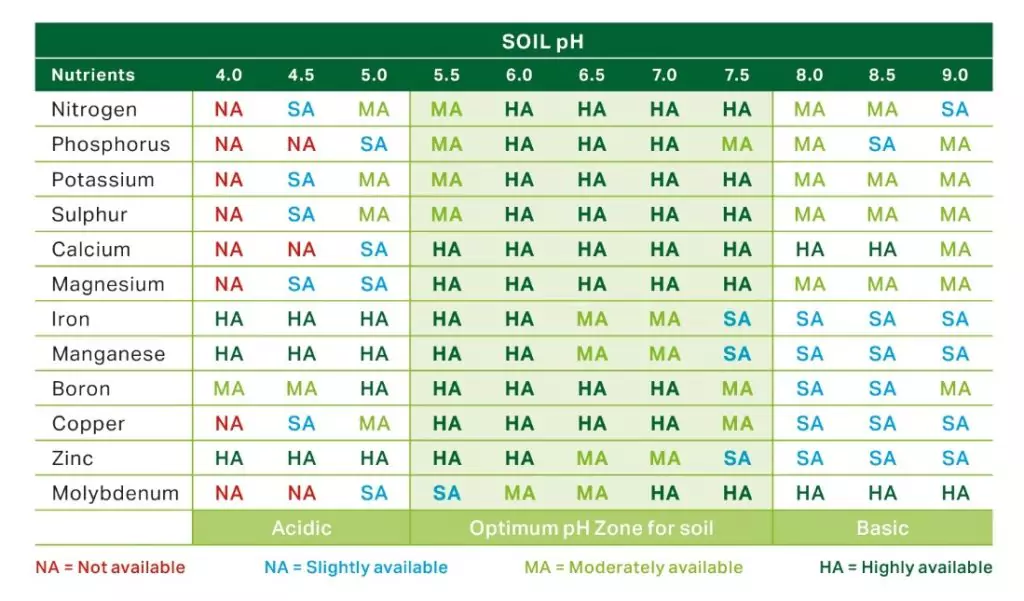
Pointers on minerals and vitamins
- Test soils to determine any mineral deficiencies
- Provide licks or mineral boluses to overcome deficiencies detected
- Avoid making overly wet silage (below 28% DM) as this may result in mineral losses in the effluent
- Inclusion of Puna II perennial chicory in a sward increases forage mineral supply and profile
- Always be vigilant about the risk of grass staggers when stock are grazing fresh spring grass
- Check phosphorous status of soil before reseeding with clovers
The clover effect
- White clover is typically richer in calcium, magnesium, iron, manganese, copper, cobalt, molybdenum, boron and selenium than ryegrass.
- Red clover is typically richer in copper and cobalt than ryegrass.
Does grass have nutritional value?
The answer is yes when asking, does grass have any nutritional value? Above, you can see that grass is rich in protein, fibre, lipids, water-soluble carbohydrates, minerals and vitamins.
The nutritional value of grass
Germinal's Aber High Sugar Grass offers numerous seed mixtures that are nutritious and have a high protein content in grass. For advice on grass production, talk to Germinal's forage experts.
